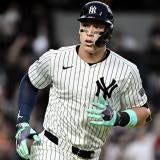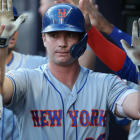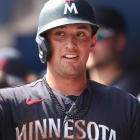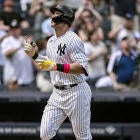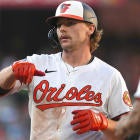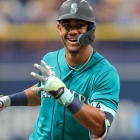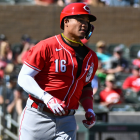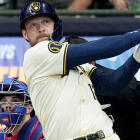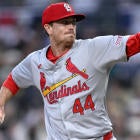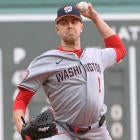The mailbag gets off to a depressing start this week.
Just a fair warning. The mood improves, but the start is a downer because, well, some people are still having some downer thoughts about baseball.
I should point out that Chris Towers and Adam Aizer aren't among them. Both expressed independently on the Fantasy Baseball Today podcast last week that they're becoming more optimistic a 2020 season will indeed commence, and Jeff Passan of ESPN has gone so far as to say a season will happen ... probably. But as we verge on May without a concrete start day, it's still reasonable to ask what happens if it doesn't.
And it's reasonable for me to answer.
What if MLB does not return? How should that effect keeper and dynasty leagues in regards to years of service and salary escalations etc?
— Brian Stines (@Miltie82) April 24, 2020
It has to be asked, I guess. Even though other aspects of life seem to be trending the right direction, professional sports brings its own you unique challenges, and it's still possible a season never gets off the ground.
One of the biggest reasons it may not is because there are so many different parties to satisfy. One of them is the players, who may be required to sequester themselves apart from their families — a big ask, to be sure.
Along those lines, Fantasy Baseball has a distinct advantage over real baseball. There aren't opposing parties with conflicting needs. There are just the owners, as in you and your leaguemates. The players aren't real. You may hold mock press conferences when you acquire them — no need to pretend otherwise — but what they're saying and doing in those conferences is being generated by your own mind. They're just data vessels incorporated into a game for your own amusement, so whatever you and your leaguemates decide doesn't have to attend to their needs.
You may have heard that, in the real game, players still get a year of service time even if the 2020 season is canceled, meaning Mookie Betts would be a free agent even though he never suited up for the Dodgers. This is one of those concessions made to satisfy the needs of real people. But because the fake game uses fake people, your league doesn't have to do that, and I see no logical reason why it would.
No one in your league gains anything (nothing that was earned, anyway) by progressing player salaries a year. Everyone just loses the effort they put in to get that point. So why not treat 2020 like it didn't happen — because it didn't — and pick up where you left off in 2021?
Do I sell off older pieces in dynasty yet? I’m getting worried.
— nemo in latin (@lostlyric) April 24, 2020
Picking up from the last question, one thing that would be lost in both the real game and the fake game in the case of a canceled season is a year from each player's window of productivity. Come the end of each one's career, we'll have to ask how the numbers might have looked if not for that blank space in the middle.
But it's even more upsetting for the ones who'll have a blank space at the end. Maybe not the very end (and I'd be fascinated to see who would opt to retire even without a farewell season), but guys like Justin Verlander, Max Scherzer and Nelson Cruz likely don't have many productive years left. They won't come with any more assurances in 2021.
Here's the problem: Everybody in your league knows it. If you start shopping those older players, everyone will know exactly why and will probably share your concerns. So it's a question of how much you're willing to discount those players and if someone else in your league is willing to discount them a little less.
It never hurts to shop around — again, fake players, so no hurt feelings — but I wouldn't hold your breath on finding an acceptable offer. Fantasy GMs are generally hesitant to take big swings at times of uncertainty, as anyone who has ever tried trading a player whose injury status was up in the air can tell you, and everyone tends to play the skeptic in trade negotiations anyway.
My assumption is that either expanded rosters or use of a universal DH for 2020 would negate any position ‘battles’ (e.g., Austin Riley and Johan Camargo in Atlanta). I would expect both to remain on the roster and the DH rule might allow both of them to play. Is this correct?
— Kevin Holmes (@KWHolmes1991) April 24, 2020
Yes, let's get back to the timeline that does include a 2020 season. I prefer to live in that one.
Your assumption is mostly correct, though it does still rely on a few corresponding assumptions. If the Braves just aren't convinced Austin Riley is ready, they may not want to jeopardize a year of service time (and it may indeed be a full year if the loss of the minor-league season makes replacements difficult to come by). Even if Riley does make the roster, it'll still be up to him to perform. Otherwise, his at-bats could go to someone like Adam Duvall, who performed well with more extensive playing time down the stretch last season.
Of course, I'm citing Riley only because it's the example you gave me. He had gotten off to such a good start in spring training that his spot would be a near certainty on an expanded roster. The bigger question would be whether a yet-to-debut prospect with vague 2020 ambitions — like, say, the Padres' MacKenzie Gore — would be awarded a spot on an expanded roster, knowing he might not see game action in 2020 otherwise. Maybe, maybe not. But I don't think it'll be a blanket approach wherein all the top prospects have jobs.
I suspect we'll see more unheralded journeymen like Duvall take those extra jobs just because the financial ramifications are too great for a prospect to misfire during this time. Where would a team send a prospect if he doesn't click right away? Does a year of service time get used up for an unsteady bench role? Veteran players offer more assurances, and many have been unfairly passed over in recent years.
It's just a guess, though. Obviously, we'll have a better idea in the weeks to come. Meanwhile, Chris Towers has already put together a list of NL players who could thrive with a universal DH.
When deciding keepers, how much do you weigh future value/best value vs winning now. Do you always take the best players or try to hedge your bets?
— daddy needs a beer (@GoGetDaddyABeer) April 24, 2020
It depends how much roster turnover is happening in your league. If every team is keeping just four or five players, then you don't need to overthink it. Good players will always be available. You'll always have a chance to restock next year.
In such a format, I'll mostly just go by the redraft rankings. If it's a close enough call, maybe I'll consider longevity. It would be nice, of course, to secure the next Mookie Betts and just keep him year after year. But when you can't count on a player to deliver now in a format that's designed for the here and now, it's an inefficient use of that keeper slot. You're not playing the game you're presented with but instead wishing it was some other game.
Other games exist, though, and if the one you're playing has every team keeping, say, 15 players, the calculation changes. When you can't count on getting quality players in a draft, you have to cultivate them yourself, and to do that, you have to aim younger with your keepers. It doesn't mean you should stash every 18-year-old in Rookie ball — fielding a competitive lineup is still your top priority — but certain top prospects would take precedence over middling major-leaguers, especially ones on the wrong side of 30.
A good rule of thumb is that if it's the sort of asset you could expect to find on the waiver wire during the season, then it isn't much of an asset. The depth of your league would have a say there, too.
If you decided to wait on a position or two in your draft, what are the positions you lose the least at by drafting late?
— Rob Weddig (@RobWeddig) April 24, 2020
You've probably heard or read me say at some point over the past few months that position scarcity isn't really a thing anymore, and so by that thinking, I think you could wait on all of them ... except starting pitcher.
But sure, if you play in a deep enough league, some positions will run out of viable starters faster than others. The drop-off is especially sudden at first base and second base, and neither offers as many sure bets a long the way. First base is in need of a youth infusion, with standbys like Paul Goldschmidt and Edwin Encarnacion beginning to show their age, and second base may still be too soon into one, requiring leaps of faith in Cavan Biggio, Tommy Edman and Gavin Lux.
The deepest position, I think, is third base, so maybe that's the easy answer to your question. Justin Turner was a top 10-player at the position for me last year and more or less performed up to expectations, but he's ranked 21st now just because someone has to be. Nos. 22 and 24 at the position, J.D. Davis and Gio Urshela, are players I've made a point to take in every draft. If either was my starter heading into the season, I still think I'd have a fighting chance.
But there are two complicating factors. The surplus at third base is itself so high-end that people are happy to double and triple up at the position, so the bankable types don't necessarily last to the end of the draft. Also, because so many at the position are so draftable, the waiver wire will be particularly thin there, meaning you can't afford to miss at the position.
The position where I'm confident I can always find interesting players late is outfield. It's so big that it's never lacking in alternatives, and even if I don't land the right ones in the draft itself, I know something will be worth grabbing on the waiver wire soon enough.
I'm also happy to wait at catcher, at least in a one-catcher league. It's known for being a weak position — and for good reason — but part of the reason two-catcher leagues exist is because a league would never need to reach deep into the catcher pool otherwise. Nobody is playing a catcher-eligible player anywhere but catcher, so in a 12-team, one-catcher league, the 12th catcher off the board is probably one you can grab in the last round. And he's probably good enough.
If we pretended fantasy baseball was just starting and 5x5 standard didn’t exist yet and you could set the standard for fantasy what hitting and pitching categories would you choose? How many of each?
— Remembersports? (@cboddy2727) April 24, 2020
It's true that the standard 5x5 categories are what they are mostly for tradition's sake, and that's not altogether a bad thing. But we know now that those traditional measures aren't the most indicative of a player's worth, and it's made for a situation today where base-stealers, of all things, are the most prized hitters. You don't need me to tell you that's totally backward.
Thing is I don't really need five categories to sum up a hitter's worth. I can do it with just two: on-base percentage and total bases. But if you're dead set on playing in a Rotisserie league, that's not enough to make things interesting, so you'll need to accept that more frivolous metrics will have to be weighed equally.
The question, then, is which ones do the least damage? Which ones won't detract from the measures we've already determined to be most meaningful? And to that end, I think runs and RBI do a pretty good job. I understand they're not high-concept stats and don't say much about a player's value on their own, but they reinforce what already makes a player good without double-counting it. And since scoring runs will always be the name of the game, they won't be skewed by whatever era we're in.
To factor in stolen bases (and weigh them more appropriately) let's add them to total bases but also subtract four bases for each home run, instead making home runs their own separate category. So for hitters, the categories would be OBP, HR, R, RBI and TB+SB-4(HR).
I have fewer objections with the pitcher categories and generally think they do a better job of measuring pitcher value, but I'd give up wins for a category that more directly rewards high-volume starting pitchers. Maybe one that simply tallies up starts of six-plus innings? The standard may need to be adjusted over the years as pitcher usage changes, but it seems just right for now.
There’s been a lot of talk about Alonso and Tatis being busts in redrafts. Does this support a sell high mentality for dynasty? Or do you more or less believe in the long term outlook of them?
— Ryan Cook (@gotem247) April 24, 2020
No, it's not the same thing at all. Risk is relative, and in a redraft context, the risk for Fernando Tatis and Pete Alonso is high. They're less than fully proven players being drafted alongside highly proven ones, and since you're only projecting for the year ahead in such a format, why take on unnecessary risk?
But in a dynasty context, they're prospects made good. Anyone who has already had success in the majors is less risky than anyone who hasn't, which makes Tatis and Alonso more valuable than just about any minor-leaguer you'll find. That's especially true of Tatis, who just turned 21 this offseason. He has a whole future ahead of him, and when your sights are set on the whole future and not just the year ahead, a certain amount of volatility is already being priced in. You accept it for the long-term payoff.
Of course, in some dynasty leagues, minor-leaguers can be kept for cheaper than major-leaguers, and if you play in such a league, it wouldn't hurt to shop Tatis or Alonso if you have long-term concerns about them. But you'd need a haul to move them now that they're already established as prime building blocks. If I had them, I'd just assume I'm married to them at this point.
Josh Rojas. Yes or no?
— Collin (@collinfug) April 24, 2020
Such an interesting player, Josh Rojas. He got a decent amount of hype when the Diamondbacks called him up last August, for those who had already moved on to football by then. He had, after all, put together a .332 batting average, 23 homers, 33 steals and 1.023 OPS between two minor-league levels and had come over from the Astros in the Zack Greinke deal just a couple weeks earlier.
Of course, he didn't come close to delivering on that hype despite playing left field virtually every day. His .217 batting average with just two home runs and four stolen bases in 157 plate appearances wasn't enough to secure him a job in 2020, and in fact, the Diamondbacks went out and signed Kole Calhoun for the job instead.
But while Rojas played the outfield almost exclusively during his stint in the majors last year, he also saw plenty of action at all four infield spots in the minors and had manned both second base and shortstop this spring. If the Diamondbacks are grooming him for a super utility role, there will be opportunities for him to make good on his potential still. He could still make a handful of starts a week and take over anywhere there's an injury.
So we shouldn't write off Rojas yet. His opportunity hasn't completely passed him by, and I have him stashed in a couple of deep leagues just in case. Still, the Diamondbacks didn't show much confidence with their offseason maneuvering, and seeing as he's almost 26, his breakthrough last year may have been partly a case of him beating up on younger competition and of a juiced ball inflating his production at Triple-A.
Which players are poised for breakouts, which sleepers do you need to jump on, and which busts should you avoid at all costs in your Fantasy football league? Visit SportsLine now to get early rankings, plus see which WR is going to come out of nowhere to crack the top 10, all from the model that out-performed experts big time last season.







